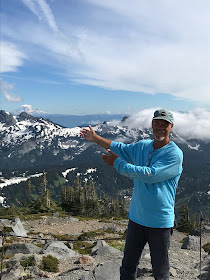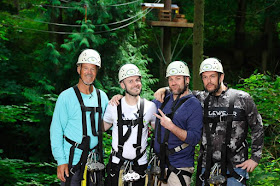 For the people who live in and around Seattle, its presence is unmistakable and its influence inescapable. It towers over its surrounding landscape and fills everyone living in its shadow with fascination and wonder each and everyday. In a cloudless sky, it is the first thing you see as you look toward the rising morning sun and the last as the day's light fades away below the Pacific horizon. This dazzling landmark is the beautiful and majestic Mount Rainier.
For the people who live in and around Seattle, its presence is unmistakable and its influence inescapable. It towers over its surrounding landscape and fills everyone living in its shadow with fascination and wonder each and everyday. In a cloudless sky, it is the first thing you see as you look toward the rising morning sun and the last as the day's light fades away below the Pacific horizon. This dazzling landmark is the beautiful and majestic Mount Rainier.Majestic Mount Rainier soars almost 3 miles (14,410 feet) above sea level. It is located 59 miles south-southeast of Seattle in the Mount Rainier National Park. Each year almost two million visitors come to Mount Rainier National Park to admire the volcano and its glaciers, alpine meadows, and forested ridges. However, the volcano's beauty is deceptive. U.S. Geological Survey research shows that Mount Rainier is one of our Nation's most dangerous volcanoes.
Mount Rainier, an active stratovolcano currently at rest between eruptions, is the highest peak in the Cascade Range. Its edifice, capped by snow and 25 glaciers, has been built up by untold eruptions over the past 500,000 years. It last erupted in 1894-95, when small summit explosions were reported by observers in Seattle and Tacoma. Mount Rainier's next eruption might be of similar or larger size and could produce volcanic ash, lava flows, and avalanches of intensely hot rock and volcanic gases, called "pyroclastic flows."
The mountain was originally named Tahoma or "Great Snowy Peak" by the Yakima Indians. Captain George Vancouver renamed it after Admiral Peter Rainier of the British Navy during a scouting expedition on May 7, 1792. This name was hotly contested for over 100 years, because Americans felt it shouldn't be named after a British officer who had never even been to the U.S. An alliance of tribal members have moved forward with a proposal to restore an original name to this Northwest landmark, but a long bureaucratic process stands in its way. A Mount Rainier spokesman says the agency doesn't currently have a position and may not take one.
Mount Rainier's summit has an average high temperature of 33 degrees and an average low of 15 degrees in July, the month we visited. There is no mistaking when you enter Mount Rainier National Park--the Nisqually Entrance--a large log constructed sign marks the entrance where you pay a $30 fee which grants unlimited entry for one vehicle and passengers for seven consecutive days. Our planned destination was Paradise at approximately 5400 feet where there is a visitor center, the Paradise Inn, the Paradise Ranger Station and the 1920-built Guide House. Most of the parks 10,000-plus annual summit bound climbers begin their arduous and rewarding quest from this location. In 2015, 10,025 climbers made the attempt and only 4,888 were successful. It is also in Paradise where you will find some of the parks most popular hiking trails.
 Before arriving at Paradise, we made a couple of stops along the way. The first stop was at Kautz Creek Trail for a beautiful view of Mount Rainier through the areas tall fir trees and the second at Narada Falls--a 176 foot falls located a mile from the Paradise area. After walking a descending path below the road, you are treated to a beautiful misty rainbow at its base where it plunges into a crystal clear pool.
Before arriving at Paradise, we made a couple of stops along the way. The first stop was at Kautz Creek Trail for a beautiful view of Mount Rainier through the areas tall fir trees and the second at Narada Falls--a 176 foot falls located a mile from the Paradise area. After walking a descending path below the road, you are treated to a beautiful misty rainbow at its base where it plunges into a crystal clear pool.The weather at Paradise was about 70 degrees and clear skies--perfect for climbing and viewing. With numerous trails to choose from, we selected the Skyline and Golden Gate Trails which ultimately took us to Panorama Point--a 4 mile trek with an 1700 foot elevation gain. Averaging 643 inches of snowfall per year, the trails were still covered with snow this early July. We walked over large slippery snow fields and climbed narrow, rocky ledges overlooking high cliffs with streams gushing past our feet. Along the way, we saw wild flower covered meadows and mountain goats clinging to rocky outcroppings. We were treated to stunning views of the summit and the sparkling Nisqually Glacier with numerous waterfalls crashing down its steep, craggy cliffs.
When we finally arrived at Panorama Point after hours of picture taking and gazing, we were standing above the cloud ladened peaks of the surrounding Tatoosh mountain range with Mount Adams shining in the sun far in the distance. Wispy clouds floated below us on the mountainscape from where we came. We took pictures and soaked in the inspirational and breathtaking scenes. In the meantime, a thick mist rolled in and covered the summit, which was no longer visible. It was time to leave. The mountain makes its own weather and we were about to experience that phenomenon.
 As we descended the rocky trail, thick clouds began to surround us and visibility became almost zero. At this point, I had hiked ahead of Jared, my son, and Frank. I could no longer see them. The markers identifying the trails had disappeared and I lost my way on the snow fields looking for the foot tracks left by earlier climbers on our way up. I was becoming concerned. While on the snow, I came across an animal dressed in a coat of golden fur. Later, I would learn it was a marmot.
As we descended the rocky trail, thick clouds began to surround us and visibility became almost zero. At this point, I had hiked ahead of Jared, my son, and Frank. I could no longer see them. The markers identifying the trails had disappeared and I lost my way on the snow fields looking for the foot tracks left by earlier climbers on our way up. I was becoming concerned. While on the snow, I came across an animal dressed in a coat of golden fur. Later, I would learn it was a marmot.For a while, I appeared to be lost on the mountain, but luckily I found my way back onto the lower trails and the parking area where I waited for Jared and Frank. It was an exciting ending to a fantastic adventure with a lesson learned; you have to pay attention to the mountain because it changes in a blink of an eye.
For the strong, experienced hikers, who are prepared with the right clothing and equipment, route-finding skills, know their limits and when to turn around when conditions are unfavorable, the next stop from Panorama Point would be Camp Muir at 10,188 feet accessed via a junction across Pebble Creek--Camp Muir is the gateway to the south side of the summit by way of the Gibraltar Route.
Hiking the trails of Paradise on Mount Rainier is the ultimate and rewarding experience. It challenges you, inspires you, and humbles you. The beauty and splendor is unforgettable. Photographs capture a snippet in time, but it is an experience that can only be fully appreciated with your own eyes. If you are feeling a little whimsical, take a slide down one of the snow fields, climbers call it glissading. I appreciatively thank Jared and Frank for taking me on this rare and awe inspiring excursion on Mount Rainier.



















